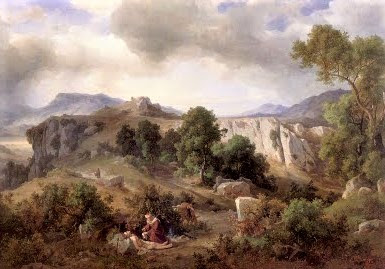Jesus was praying in a certain place, and when he ceased, one of his disciples said to him, "Lord, teach us to pray, as John taught his disciples." And he said to them, "When you pray, say: "Father, hallowed be thy name. Thy kingdom come. Give us each day our daily bread; and forgive us our sins, for we ourselves forgive every one who is indebted to us; and lead us not into temptation."- Luke 11:1-4
It was an ordinary practice for a rabbi to teach his disciples a simple prayer which they could use on a regular basis, and it would be a prayer that encapsulated the teaching they had imparted to their followers. The prayer Jesus gives to his apostles teaches everything necessary to know about how to pray, and for what to pray.
It begins by addressing God as Father, indicating to us that in prayer we are not coming to someone from whom we must try and extract gifts, but we approach a Father who takes delight in supplying His children's needs.
In Hebrew thought the idea of “name” means more than just the name by which a person is called. The name means the whole character of the person as it is revealed and known to us, and this is why Jesus teaches that God’s Name is a holy name. Psalm 9:10 says, "Those who know thy name put their trust in thee." To know the name of God is to know the whole character and mind and heart of God, and makes us willingly put our trust in Him.
The order of the Lord's Prayer is important. Before we ask anything for ourselves, the first order of business is that of God and His glory, and the reverence which is due to Him. Only when we give God His proper place will other things fall into proper order.
Notice how this prayer covers everything in life. It covers our present need, in that it tells us to pray for our daily bread, and indeed it is bread for the day for which we ask, providing a link to the story of the manna in the wilderness (Exodus 16:11-21). Only enough for the needs of the day could be gathered. We are not to worry about the unknown future, but to live a day at a time, which is a reminder of our dependence on God.
The prayer refers to our sin. When we pray, all we can really do is pray for forgiveness, because even the best among us is a sinful man coming before the purity of God. And as we seek forgiveness, so we need to give forgiveness.
It covers future trials, asking that we not be brought to them. “Temptation” means any situation in which we are tested. It includes far more than seduction to sin. It covers every situation which is a challenge to us, and which tests a person's humanity and integrity and fidelity. We cannot escape it, but we can meet it with God. People have asked, “Why would God lead us into temptation?” That’s not really what the prayer is saying, and the Greek is better understood as saying “Let us not be led into temptation.” In other words, in this prayer we are asking God to protect us from going off into whatever direction temptation might take us.
The Lord's Prayer is a public prayer of the Church, with its proper place in the liturgy. But it also is a private prayer, which stirs up all manner of holy desires which lead us on into right ways, while at the same time it sums up all we ought to pray for in the presence of God.




















